
A formidable weapon in the fight against viral diseases turned out to be an antiviral drug of a new generation, which combines drugs with both targeted action and a wide range of lesions. The dominant number of viral infections have a tendency for prolonged or chronic course. Their list does not consist of one dozen items. Among these diseases is also the herpes virus.
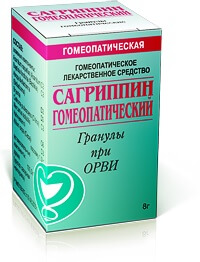 This topic should not start with the flu. And first, you need to find out the difference between ARI and ARVI. In the first case, we have a sharp respiratory disease, and here we are talking about a cold, or its possible complication. The second case is more complicated, because we are talking about a viral lesion. When we talk about a cold, we rarely mention a rise in temperature. In the case of ARVI, it may rise from 37 to the maximum.
This topic should not start with the flu. And first, you need to find out the difference between ARI and ARVI. In the first case, we have a sharp respiratory disease, and here we are talking about a cold, or its possible complication. The second case is more complicated, because we are talking about a viral lesion. When we talk about a cold, we rarely mention a rise in temperature. In the case of ARVI, it may rise from 37 to the maximum.
Particular attention must always be paid to the 37 mark. This body temperature signals a leak inflammatory processes... Especially if it stays within 37 - 37.5 for some time.
The modern influenza virus is capable of destroying only new generation drugs. These modern guards do an excellent job with another kind of ARVI. Among them, Ingavirin takes a special place.
Ingavirin: a weapon against the flu
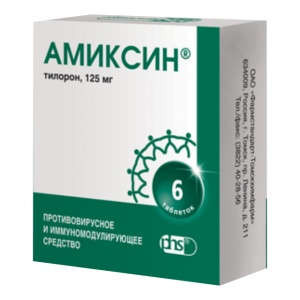
Most people treat ARVI with tea with raspberries or lemon. Such natural remedies are not able to provide the necessary resistance to modern viruses. Way out: use drugs of a new generation. Among them it is worth noting Ingavirin... Its packaging is shown in the photo. It is inappropriate to use it for colds, because Ingavirin, like many other drugs, affects the state of the human immune system. This is especially true for children.
This antiviral drug relieves the primary symptoms of viral infection:
- blocks the further development of the virus;
- suppresses its reproductive functions;
- has an anti-inflammatory effect.
It must be remembered that, despite all its effectiveness, Ingavirin cannot be taken without first consulting a general practitioner.
Ingavirin is especially effective in the fight against influenza viruses of the A, B strains and the famous "swine flu". It effectively resists:
- parainfluenza;
- adenovirus infections;
- respiratory syncytial infections.
 Such drugs as Ingavirin not only destroy influenza viruses, but are also completely eliminated from the body within 24 hours. This property makes Ingavirin absolutely safe. He is not capable of causing harm, and after the completion of the reception. You should not take Ingavirin without first familiarizing yourself with its contraindications.
Such drugs as Ingavirin not only destroy influenza viruses, but are also completely eliminated from the body within 24 hours. This property makes Ingavirin absolutely safe. He is not capable of causing harm, and after the completion of the reception. You should not take Ingavirin without first familiarizing yourself with its contraindications.
Despite their toxicity, such drugs have minimal effect on the liver. In the fight against influenza or other acute respiratory viral infections, drugs provide maximum effectiveness at the time of the initial stage of the disease. Otherwise, even Ingavirin will not be able to give quick and desired relief. This is especially true for children.
Speaking about the influenza virus, or ARVI, you must remember about the incubation period. The entry of the virus into the body is always accompanied by:
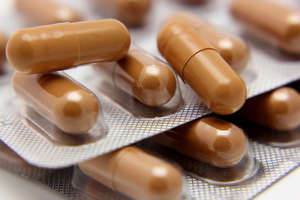
The danger of influenza and / or ARVI lies not only in the manifestation of symptoms the same as with a cold, but also in the fact that the disease is accompanied by a rather dangerous complicationsif the timely health care... If Ingavirin is taken on time, complications can be avoided.
Do not take Ingavirin as a panacea for any strain of influenza or ARVI.
After all, the medicinal list consists of a wide range of drugs intended for their special cases. According to its pharmacological properties, Ingavirin acts on certain viruses. Based on the fact that they constantly mutate Ingavirin can be effective in combination with other drugs.
Tamiflu against ARVI
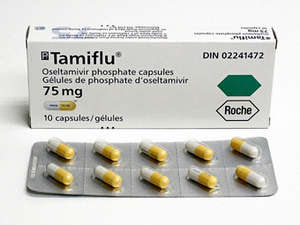
The flu virus has never been dangerous. He was always spoken of as a cold, he was never treated like ARVI. Until the swine flu came. Exactly Tamiflu changed the fate of the terminally ill, “burned out” from the inside in 72 hours. Remember - you cannot take Tamiflu without the permission of a qualified therapist. Tamiflu is effective against the influenza virus by its direct effect on it, preventing further reproduction. One capsule contains 75 mg of the active ingredient Tamiflu. Tamiflu is known to be allergic to oseltamivir.
Tamiflu is contraindicated for children.
The maximum efficiency is achieved if the influenza virus is present in the body for no more than two days.
Based on a reliable safety profile, Tamiflu can be taken with other medications in the fight against SARS or influenza virus. Tamiflu packaging is shown in the photo. Tamiflu is also safe in a duet with antipyretic drugs. 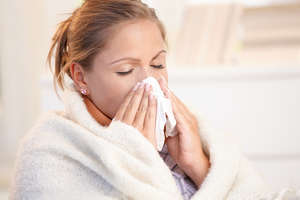 When you contact the doctor who prescribed Tamiflu for you, be sure to tell us about the drugs that you may be taking now and only in terms of treating ARVI or influenza.
When you contact the doctor who prescribed Tamiflu for you, be sure to tell us about the drugs that you may be taking now and only in terms of treating ARVI or influenza.
Tamiflu is taken in the morning and evening. Possibly slight stomach discomfort. If you forget about taking Tamiflu, then drink it immediately, but no later than two hours before the next dose. The minimum duration of Tamiflu treatment is 5 days. It is forbidden to offer Tamiflu to other patients. Drugs such as Tamiflu can, in rare cases, cause vomiting or nausea.
Immunomodulators
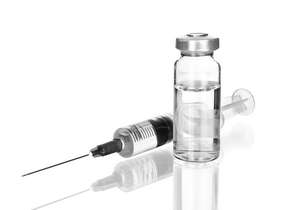 An additional weapon against influenza and ARVI is immunomodulatory drugs. Among them, widespread Amiksin and Cycloferon... They increase the intensity of interferon production and maintain its required level in the blood.
An additional weapon against influenza and ARVI is immunomodulatory drugs. Among them, widespread Amiksin and Cycloferon... They increase the intensity of interferon production and maintain its required level in the blood.
Amiksin
A drug called Amiksin has proven itself well. It is synthetic. Amiksin is used for a more intensive production of interferon by the body. Thanks to such actions, Amiksin significantly raises not only the immune system, but is also an excellent antiviral agent.
A kind of antiviral drug Amiksin is not toxic and, at moderate dosages, is perfectly tolerated. Amiksin is not intended for children under 7 years of age. For colds, it is advisable to use Amiksin. Amiksin is taken after meals. The course of treatment depends on the severity of the disease in a dosage of 125 mg or 250 mg. Among the side effects:
- slight chills;
- mild indigestion;
- allergic reaction.
During pregnancy, lactation and breastfeeding Amiksin is contraindicated for use.
Cycloferon
This antiviral drug is an immunomodulatory and antiviral agent. Apply Cycloferon for the treatment of ARVI, influenza and herpes viruses. The recommended antiviral drug, as its name suggests, triggers a certain cycle of interferon production in the body and maintains it at the proper level, despite its rapid excretion by the kidneys.
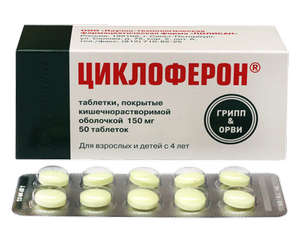 Cycloferon is prescribed in tablets or in ampoules. In the first case, Cycloferon is taken 30 minutes before meals, once a day. In the second case, Cycloferon is administered intravenously or intramuscularly once a day according to the basic scheme. If we are talking about the treatment of herpes, then Cycloferon, as an antiviral drug, is applied to the surface in the form of a gel substance.
Cycloferon is prescribed in tablets or in ampoules. In the first case, Cycloferon is taken 30 minutes before meals, once a day. In the second case, Cycloferon is administered intravenously or intramuscularly once a day according to the basic scheme. If we are talking about the treatment of herpes, then Cycloferon, as an antiviral drug, is applied to the surface in the form of a gel substance.
Taking Cycloferon, only allergic side reactions are possible.
Cycloferon is contraindicated in case of:
- cirrhosis of the liver;
- allergic reactions;
- pregnancy;
- breastfeeding;
During lactation, Cycloferon is approved for use.
Cycloferon is fully compatible with other drugs. No cases of overdose were noticed. The tablets are coated with a special coating. The antiviral drug Cycloferon is packed in polymer cans or blisters.
As a solution for injection, Cycloferon is sold in 2 ml ampoules. Store Cycloferon in a dark place. Such drugs as Cycloferon are able to destroy not only the influenza virus, herpes, ARVI, but are also applicable for colds. Cycloferon is not applicable for children under 4 years of age.
Effective herpes treatment
 Various medications are available for herpes. It is recognized as an antiviral drug capable of effectively destroying the herpes virus Valtrex... It cannot be used for colds, due to a specific direction. The photo shows the packaging of the drug.
Various medications are available for herpes. It is recognized as an antiviral drug capable of effectively destroying the herpes virus Valtrex... It cannot be used for colds, due to a specific direction. The photo shows the packaging of the drug.
Valtrex
Drugs such as Valtrex are used to kill the herpes virus. Valtrex is perfectly absorbed by the intestines. The maximum concentration of Valtrex in the blood is observed after one to two hours. Valtrex is used in case of herpes zoster, genital herpes, labial herpes or labial. Valtrex is effective in treating herpes simplex, in the case of the first symptoms of the disease.
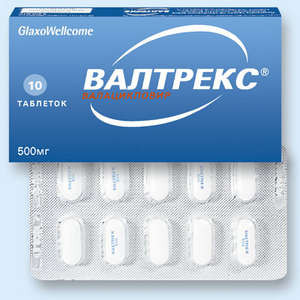
If the infected partner takes Valtrex, then the symptoms of the course of the disease can be reduced to a minimum. Valtrex is contraindicated for children. It has been used since adolescence. The antiviral drug Valtrex is dosed exclusively by a doctor. For the purpose of prevention, Valtrex is prescribed twice a day, based on the daily rate of 500 mg.
Side effects are possible when using Valtrex to treat herpes. This drug can cause:
- diarrhea;
- nausea;
- vomiting;
- hives;
- rash;
Very rarely, after the use of Valtrex, impaired renal function and shortness of breath were observed.
It is forbidden to use Valtrex during pregnancy, lactation and breastfeeding.
Valtrex is effective in the treatment of herpes and in old age. However, it requires a significant increase in fluid intake. This drug can be stored for 3 years from the date of issue. Exceeding this period will make the treatment of the herpes virus ineffective. When it comes to herpes, it is better to use Valtrex.
Caution - bronchitis
 With bronchitis, an increase in temperature is not always observed. It is especially dangerous for young children, babies in particular. A dry cough is often present with bronchitis. Duration of three days requires medical attention. It is very important for bronchitis to consume as much liquid as possible. Difficulty breathing and a bursting cough from the inside are constant companions with bronchitis. This disease is viral, so a cold is out of the question. However, treatment for colds and bronchitis will be radically opposite. In children under three years of age, bronchitis severely spasms the bronchi.
With bronchitis, an increase in temperature is not always observed. It is especially dangerous for young children, babies in particular. A dry cough is often present with bronchitis. Duration of three days requires medical attention. It is very important for bronchitis to consume as much liquid as possible. Difficulty breathing and a bursting cough from the inside are constant companions with bronchitis. This disease is viral, so a cold is out of the question. However, treatment for colds and bronchitis will be radically opposite. In children under three years of age, bronchitis severely spasms the bronchi.
Doctor Komarovsky focuses on the fact that bronchitis is caused in children respiratory viruses... However, with bronchitis 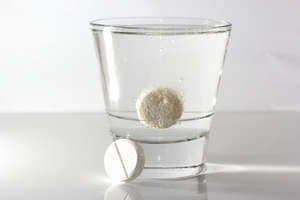 the concepts of antibiotic and treatment of children are incompatible. The main thing is fresh air, ventilation and maximum drinking. Therefore, it is necessary to understand that a course of antibiotics cannot save either children or adults because a lump of mucus can simply block the bronchus. A very important point in bronchitis is fresh air, but not humid or too cold. This is especially true for young children.
the concepts of antibiotic and treatment of children are incompatible. The main thing is fresh air, ventilation and maximum drinking. Therefore, it is necessary to understand that a course of antibiotics cannot save either children or adults because a lump of mucus can simply block the bronchus. A very important point in bronchitis is fresh air, but not humid or too cold. This is especially true for young children.
What is HPV
The abbreviation HPV stands for Human Papillomavirus. HPV is most common in women. It is extremely rare in children. HPV belongs to the papovirus family, which contains two strands of DNA. The size of the HPV is very small. There are two risk groups for HPV, highly oncogenic and low oncogenic.
 More than 130 types of HPV are known, among them 30 are capable of affecting the genitals. Each HPV virus has its own serial number. It is transmitted sexually by HPV. The incubation period for HPV is about 3 months. Oral transmission of HPV is no exception. The process of HPV lesion is multistage. It takes several years for metastases to form.
More than 130 types of HPV are known, among them 30 are capable of affecting the genitals. Each HPV virus has its own serial number. It is transmitted sexually by HPV. The incubation period for HPV is about 3 months. Oral transmission of HPV is no exception. The process of HPV lesion is multistage. It takes several years for metastases to form.
In 80% of cases, HPV is not a deadly virus. There are no well-defined treatments for HPV. All of them resemble the treatment of cancer. In the fight against HPV, the most effective is the combined complex method against the background of local and systemic antiviral treatment. In the fight against HPV, medications are also used. Vivid symptoms of HPV are warts, or genital warts that appear on the mucous membranes and genitals.
In the autumn-winter period, the frequency of acute respiratory viral infections increases significantly. There are a lot of viruses that infect the respiratory tract - about 300 species, but the most common of them are viruses, parainfluenza, respiratory syncytial infection, as well as rhino and adenoviruses.
Treatment of acute respiratory viral infections should be carried out in 3 directions: etiotropic (that is, the effect on the cause of the disease, on the virus itself), pathogenetic (drugs affect the mechanisms of the development of the disease) and symptomatic (elimination of unpleasant symptoms for the patient caused by the disease). This article will focus on the drugs of the etiotropic treatment of ARVI, that is, about antiviral drugs.
A few words about the principles of etiotropic treatment of ARVI
Many of us are accustomed to taking out all kinds of drugs from the nightstand at the slightest sneeze or coughing and receiving intensive treatment. Also, many people start taking an antibiotic from the first day of ARVI. This is fundamentally wrong! Antibacterial drug acts precisely on bacteria, and with ARVI, the cause of the disease is a virus, and only on the 5-7th day of malaise it is possible to attach a secondary bacterial flora, when the use of an antibiotic is advisable. And for preventive purposes, the drugs of this group, alas, do not work.
The drugs of choice when the first symptoms of ARVI occur are antiviral agents... With milder forms of the disease, you can do without them: he himself will overcome the infection. However, if a cough, a runny nose appears suddenly, is very pronounced, plus the temperature has also risen, then you cannot do without an antiviral drug. It is important to know that these drugs are effective only for diseases when an infectious agent actively multiplies and spreads throughout the body: you should start taking them as soon as you realize that you are getting sick. On days 3-4-5, ARVI therapy with antiviral agents will not have the desired effect. That is why it is impossible to hesitate with the treatment of colds and flu. The habit of most of our compatriots to postpone therapy, to carry the disease on their feet leads to the fact that almost half of the sick are at risk of complications: bronchitis, pneumonia, sinusitis, even sometimes pyelonephritis, stomatitis. The appearance of the first symptoms of flu - chills, runny nose, fever - should be a signal to start treating a cold.
Classification of antiviral drugs
Antiviral drugs used for influenza and ARVI, depending on the origin and mechanism of their action on viruses, are divided into several groups:
- Interferons;
- Interferon inducers;
- Cyclic amines;
- Neuraminidase inhibitors;
- Herbal antiviral drugs;
- Other drugs.
Let us consider each of the groups and their representatives in more detail.
Interferons
Interferons are a group of protein substances that are produced by cells, infected viruses... The main function of these substances is to prevent the multiplication of viruses in cells. That is, interferon is the most important factor in the body's defense against viral infection. To support the body during acute respiratory viral infections, to facilitate its task and speed up recovery, scientists proposed to inject interferon, obtained from human donor blood, into the affected body. Later, a number of interferon preparations were obtained artificially: by the method of genetic engineering.
Human leukocyte interferon
It is in the form of a powder, intended for the treatment and prevention of ARVI, in particular, influenza.
It is used in the form of a solution, which is prepared in boiled water at room temperature.
The drug should be taken when there is a threat of SARS infection (before contact with an infected person or before visiting a crowded place during an epidemic) and continue until there is a risk of getting sick.
Before use, the ampoule with the powder is opened, diluted with water, shaken until the contents are completely dissolved, and then 5 drops of the resulting solution are injected into each nasal passage. The frequency of administration is 2 times a day.
In the event that an ARVI infection has already occurred, it is not necessary, but a therapeutic dose of the drug. Its effectiveness is the higher, the earlier the treatment is started. Introduce 5 drops into each nasal passage every 1-2 hours at least 5 times a day for three days. The introduction of interferon is more effective: the contents of 3 ampoules must be dissolved in 10 ml of warm (at least 37 ° C) water; carry out inhalations twice a day during the first 3 days of illness.
You can use interferon for viral: instill one drop in each eye every 1-2 hours.
Grippferon
Combination preparation containing recombinant human α-interferon and several other components. It is also used to treat and prevent influenza and other acute respiratory viral infections. Apply intranasally, three drops in each nasal passage once every 3-4 hours.
Individual hypersensitivity to drug components is also contraindicated.
Viferon
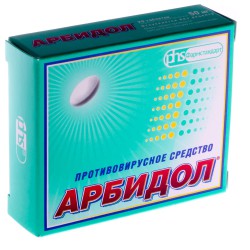 Viferon is an alpha-interferon produced in the form of rectal suppositories. It can also be used for ARVI. It is used, as a rule, in case of illness.
Viferon is an alpha-interferon produced in the form of rectal suppositories. It can also be used for ARVI. It is used, as a rule, in case of illness.
Interferon inducers
Drugs of this class stimulate the formation of its own interferons in the body. Effective against a wide range of viruses, in particular for influenza and other acute respiratory viral infections.
Tiloron (Amiksin, Lavomax)
The most prominent representative of the drugs in this group.
With influenza and other acute respiratory viral infections, adults are recommended to take 125 mg orally once a day for the first two days of illness, and starting from the 3rd day - 125 mg once every 48 hours. The dose for the course of treatment is 750 mg. For the purpose of prophylaxis, 125 mg are prescribed orally once a week for 6 weeks.
Against the background of taking the drug, nausea, a short-term increase in body temperature are possible, very rarely - allergic reactions.
Umifenovir (Arbidol, Arpeflu, Arbivir, Immustat)
In addition to interferon-inducing activity, it stimulates cellular immunity, increasing the body's resistance to infections.
For the purpose of prophylaxis, in case of contact with a patient, 0.2 g per day is taken for 10-14 days. During the period of seasonal increase in the incidence of influenza and ARVI - 0.1 g per day, once every three days for three weeks.
For the purpose of treatment, it is recommended to take 0.2 g 4 times a day for three days in a row.
Drugs based on umifenovir are contraindicated in case of individual hypersensitivity to it, as well as in severe concomitant somatic pathology.
Of side effects it is worth noting only allergic reactions in case of individual hypersensitivity to the drug.
Cyclic amines
Of the drugs in this group, rimantadine is best known.
Rimantadin (Remavir, Remantadin-KR)
 The mechanism of action of rimantadine is to inhibit the reproduction of the virus due to the violation of the formation of its envelope.
The mechanism of action of rimantadine is to inhibit the reproduction of the virus due to the violation of the formation of its envelope.
Release form - tablets and powder dosed in sachets (used in children).
For prophylaxis, one tablet (50 g) is prescribed once a day for 10-14 days.
Rimantadine is contraindicated in case of hypersensitivity to the components of the drug, in the case of severe and, as well as during pregnancy and lactation.
It is well tolerated, but occasionally unpleasant effects such as vomiting, loss of appetite, dizziness, insomnia, impaired coordination of movements, drowsiness, irritability, increased agitation, disturbances in taste and smell, palpitations, arterial hypertension, loss of consciousness, ringing or noise in tinnitus, bronchospasm, allergic reactions and itching. After discontinuation of the drug, side effects usually disappear on their own.
It is prescribed with caution to persons suffering from epilepsy, severe, liver and kidney. In renal failure, lower doses of the drug should be taken.
Neuraminidase inhibitors
Medicines of this group act exclusively on the influenza virus: they inhibit the formation of the neuraminidase enzyme by them, which promotes the release of the virus from an infected cell. As a result, influenza virions do not leave the epithelial cells. respiratory tractand die there. As a result, the severity of flu symptoms decreases and recovery occurs in a shorter time. Unfortunately, neuraminidase inhibitors have a number of serious side effects. So, against the background of their reception, it is possible to develop psychosis, hallucinations and other mental disorders, as well as disorders of consciousness.
The drugs with proven efficacy against the influenza virus are zanamivir and oseltamivir.
Zanamivir (Relenza)
It is applied only with the help of a special device - dischaler, by inhalation through the mouth. For the purpose of treatment, 2 inhalations are prescribed (this is 10 mg of the drug) twice a day for five days. As a preventive measure, it is recommended to take 2 inhalations once a day for 10 days to one month.
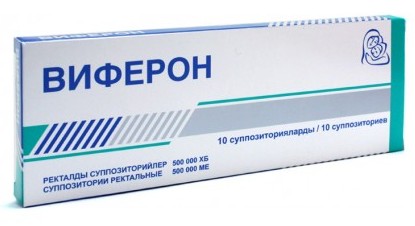 Contraindication to taking zanamivir is hypersensitivity to the drug components.
Contraindication to taking zanamivir is hypersensitivity to the drug components.
The side effects have been described above. You can also add the likelihood of developing allergic reactions in response to the introduction of zinamivir.
Studies of the drug on pregnant women and women during lactation have not been carried out, therefore it is undesirable to use this medicine in these categories of patients.
Oseltamivir (Tamiflu, Tamivir)
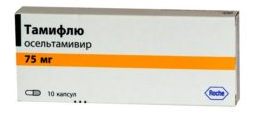 Available in the form of tablets and powder for the preparation of a suspension for oral administration (dosage form for children).
Available in the form of tablets and powder for the preparation of a suspension for oral administration (dosage form for children).
It is recommended to take 75 mg twice a day for 5 days, preferably with meals. In case of insufficiency of renal function, when the creatinine clearance rate is 30 ml / min or less, the dose of the drug should be reduced to 75 mg once a day.
Oseltamivir is contraindicated in case of hypersensitivity to it, as well as during pregnancy and lactation.
Herbal antiviral agents
The most famous among the drugs in this group are Altabor, Immunoflazid, Proteflazid, Flavazid.
Altabor
The active ingredient of this drug is a dry extract of alder seedlings, the active components of which induce the body to synthesize its own interferon and inhibit the activity of neuraminidase of the influenza virus. In addition, the drug has a destructive effect on many types of bacteria.
For preventive purposes, it is recommended to take 2 tablets three times a day. The tablet should be slowly dissolved in the mouth. For the purpose of treatment, also take 2 tablets, slowly dissolving in the mouth. Frequency rate of admission - 4 times a day. The duration of treatment is one week.
Altabor is contraindicated in case of increased sensitivity of the patient's body to it. In the same case, while taking the drug, allergic reactions may develop.
During pregnancy and lactation, this drug is not recommended, since there are no data regarding its safety for the child.
Imunoflazid, Proteflazid, Flavoside
These are drugs from the same pharmaceutical company with a similar composition and similar effects to each other.
The basis of these medicines is made up of liquid extracts of the grass Pike turf and Veinik ground.
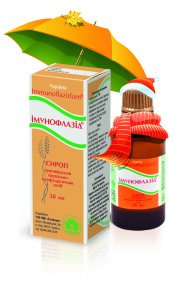 The mechanism of action of the drugs lies in the inhibition of its virus-specific enzymes by the active components, which leads to a decrease or cessation of the reproduction of viruses. In addition, the drug inhibits viral neuraminidase, stimulates the production of endogenous interferon, and also has an immunomodulatory effect.
The mechanism of action of the drugs lies in the inhibition of its virus-specific enzymes by the active components, which leads to a decrease or cessation of the reproduction of viruses. In addition, the drug inhibits viral neuraminidase, stimulates the production of endogenous interferon, and also has an immunomodulatory effect.
Proteflazid is available in the form of drops, which are recommended to be taken according to the scheme: the first 7 days of treatment - 7 drops twice a day: from 8 to 21 days of treatment - 15 drops twice a day; from 22 to 30 days of treatment - 12 drops twice a day. The duration of treatment is one month.
Flavazid is taken in 5 ml of syrup twice a day from the 1st to the 3rd days of illness, and starting from the 4th - 8 ml also twice a day.
These drugs are contraindicated in case of individual intolerance to the patient's body.
Side effects are rare. In isolated cases, patients note the appearance of nausea, vomiting, stool disorders, headache, weakness, dizziness, fever and allergic reactions that occur during treatment.
Other antiviral agents
This class of drugs used as etiotropic treatment for influenza and other acute respiratory viral infections includes drugs that are not included in any of the groups described above. These are inosine pranobex, Amizon and Engystol.
Inosine pranobex (Groprinosin, Inosin, Novirin)
It is an antiviral agent that also has immunomodulatory properties. The mechanism of the antiviral effect is to suppress the synthesis of the virus by embedding the component of the drug in the part of the cell affected by the virus, as a result of which the structure of the genetic material of the virus and its ability to reproduce is disrupted.
Apply the drug inside. The average dose is 6-8 tablets per day for 3-4 doses. To be more precise, the daily dose of the drug is 50 mg per 1 kg of the patient's body weight. The maximum daily dose is 4 g. The duration of treatment with inosine pranobex is 5-14 days in case acute illness and 1-2 weeks longer with a prolonged course.
Contraindications to the use of Groprinosin are hyperuricemia (increased levels of uric acid in the blood), as well as individual hypersensitivity to the components of the drug.
One of the most common side effects of inosine pranobex is an increase in the level of uric acid in the blood and urine while taking the drug. Indicators of this substance return to normal immediately after stopping treatment.
Patients taking Inosine may complain of feeling unwell, general weakness, nausea, vomiting, stomach discomfort, headache, dizziness, volatility, and allergic skin rash and itching. Rarely, diarrhea, sleep disorders or drowsiness, nervousness, dizziness and acute allergic reactions occur: anaphylactic shock, angioedema and the like.
It is not recommended to use these medicines during pregnancy and lactation, since there is no data regarding their safety for the child.
Engystol
A complex homeopathic preparation with a pronounced antiviral effect.
A single dose for adults is one tablet, which should be sucked under the tongue. A single dose is taken three times a day 20 minutes before a meal or 60 minutes after it. In acute onset of the disease, Engystol should be taken 1 tablet every 15 minutes for the first 2 hours. Later - according to standard recommendations - three times a day.
Allergic reactions may occur while taking Engystol.
The question of whether it is worth taking this drug for pregnant and lactating women is decided exclusively by the attending physician.
Homeopathic remedy for adults and children (from 3 years old). It is recommended for use in the treatment of ARVI as part of complex therapy (in combination with antibiotics, antipyretics, antihistamines).
Amizon
This drug belongs to the group of non-narcotic analgesics. Its main effects are antipyretic, anti-inflammatory, analgesic, and interferonogenic.
When treating influenza and other acute respiratory viral infections, the drug is taken at 0.25 g (one tablet) three times a day. The course of treatment is 5-7 days.
Amizon is contraindicated in the first 12 weeks of pregnancy, as well as in case of individual hypersensitivity of the patient's body to iodine preparations.
Of the side reactions, it should be noted increased salivation, bitterness in the mouth, a slight swelling of the oral mucosa.
In conclusion, we would like to note once again that the information provided above on drugs is intended only for information. In case of illness, you should not self-medicate, but you should consult a doctor as soon as possible.
Which doctor to contact
If symptoms of a viral infection appear, you should consult a physician or pediatrician. If the disease is severe, the patient is hospitalized in an infectious diseases hospital. Pneumonia caused by viruses is treated by a pulmonologist. With repetitive viral infections you should consult an immunologist.
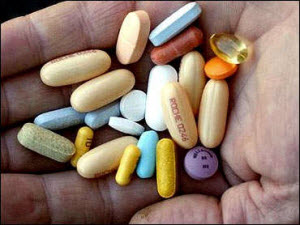 Acute respiratory viral infections (ARVI) and influenza provoke 70% of infectious colds... Almost everyone experiences the effects of the virus every year. Such high statistical indicators are due to the wide variety of pathogenic organisms that are constantly changing, and the ease of infection.
Acute respiratory viral infections (ARVI) and influenza provoke 70% of infectious colds... Almost everyone experiences the effects of the virus every year. Such high statistical indicators are due to the wide variety of pathogenic organisms that are constantly changing, and the ease of infection.
Despite the large number of drugs against ARVI, treatment makes it difficult for the symptoms of diseases caused by different viruses to be similar. Some flu drugs are sensitive only to a specific strain of the organism and will not be as effective against infections caused by other pathogens. Therefore, it is better to use antiviral agents to prevent ARVI, and if an infection has occurred, start treatment as soon as possible.
Treatment of influenza and ARVI: drugs and their effect
There are several classifications that systematize the whole variety of drugs against viral diseases... The drugs differ in chemical composition depending on the active ingredients and their derivatives:
- interferon and its inducers;
- nucleosides;
- lipids;
- thiosemicarbazone;
- ladolcarbolic acid;
- adamantane;
- plant components.
Depending on the type of virus to which the drug is sensitive, two groups of drugs are distinguished:
- funds aimed at combating DNA viruses: herpes, chickenpox and natural smallpox, cytomegalovirus, hepatitis B and C, shingles;
- funds aimed at combating RNA viruses: immunodeficiency, influenza A and B, respiratory syncytial virus.
There are other types of drugs that do not fall under these classifications: homeopathic, immunostimulating, vaccines and drugs acting on the principle of antibacterial analogues.
Antiviral drugs for ARVI are considered the best treatment option, since they eliminate the very cause of the disease. As a result, a person recovers 2-3 days earlier than without the use of this category of drugs. The cold itself goes away easier, without complications and exacerbations of others chronic inflammation... The sooner you start taking the medicine, the fewer cells the virus can infect. This means that it will not spread throughout the body and the symptoms of a cold will not be so severe.
Of course, the body itself is able to protect itself from infection with antibodies and interferons. But some types of viruses can inhibit their action, and then you cannot do without special antiviral agents. But they also need to be changed periodically, since viruses mutate and acquire resistance to the active substance of the drug.
Preparations for influenza and ARVI of chemical origin
All drugs in this group consist of substances obtained by chemical synthesis. Their action prevents the virus from multiplying at a certain stage in its life cycle. In this case, the normal functioning of human cells is not interrupted.
Anti-influenza drugs
Before choosing a medicine, you need to make sure that the disease is actually caused by the influenza virus and determine its type. Antiviral drugs for influenza are divided into two groups depending on the mode of action and the strain of the virus that they infect.
The first group includes M2-channel blockers. These drugs are sensitive to the influenza A virus. They block the M2 ion channels in the body of the virus, thereby preventing it from invading and multiplying in human cells. The active substance of drugs in this group is a synthesized amine - amantadine and its derivatives (rimantadine, deytiforin, midantan).
The most popular drug is rimantadine. Forms of rimantadine for influenza and acute respiratory viral infections: rimantadine tablets for adults and algirem syrup for children. For medicinal purposes, they are used according to the instructions and recommendations of the doctor, but no more than 5 days, for preventive purposes - within two weeks. Reception must be started on the first day of the onset of symptoms of the disease. Moreover, healthy family members must also use the drug so as not to get infected. The effectiveness of rimantadine against influenza A virus is at least 70%. Symptoms of influenza B virus disease have also been alleviated.
Medicines for influenza of the second group are neuroaminidase inhibitors. Their action extends to strains A and B. Inhibition of the neuroaminidase enzyme allows achieving several positive results:
- prevent the virus from entering the human cell;
- reduce the spread of the virus throughout the body;
- prevent the development of inflammation in the focus of a viral infection;
- relieve symptoms of the disease - fever, loss of appetite, body aches.
Medicines of this group are 70% effective in preventive measures. It is important for a sick person to take the drug in the first two days after the onset of the disease, and the sooner the better. Then he will recover 1-3 days faster. In 85% of cases of taking these drugs, the disease is mild.
Neuroaminidase inhibitors include two types of substances:
- oseltamivir - Tamiflu preparation in the form of capsules and powder for suspension preparation;
- zanamivir is a Relenza inhalation drug.
Broad-spectrum drugs
These funds are used in cases where it is not known exactly whether the disease is caused by the flu or another virus. The most popular medicines for influenza and ARVI in this category are:
- Ribavirin. Used to treat diseases caused by the respiratory syncytial virus. It will also be effective for the flu. With the help of this drug, inhalation is done, but only in a hospital setting, as it can cause serious side effects.
- Filmokonaril. It acts against rhinoviruses and enteroviruses that cause ARVI and meningitis.
- Arbidol. Suitable for the treatment of both influenza and SARS. It has an immunostimulating effect.
Drugs that increase the content of interferon
Means of this category contain either synthetic interferon, similar in effect to natural, or substances that can increase the production of interferon by the body. They resist any virus, shortening the duration of the disease and significantly alleviating its symptoms. There are some features of the use of these drugs:
- it is important to start taking interferon as early as possible;
- if the disease is caused by bacterial activity, these drugs are ineffective. In this case, you need to take antibiotics;
- in case of severe influenza, special antiviral drugs (tamiflu, rimantadine, relenza) with interferon. It can be used as part of complex therapy.
Interferons
Interferons are special proteins in the body that provide an immune response to a viral attack. Their versatility is due to the mode of action: interferons prevent the virus from multiplying at the initial stage, which is mandatory for all strains. Since these substances are produced by the body, then the drugs containing them have practically no contraindications, except for hypersensitivity to a foreign protein. The effect after taking the drug appears already after 1-3 days. The medicine can be used in both the acute and latent phase of the disease.
For treatment, α- and β-interferons are used. They are sold as a powder for injection or for preparation of nasal solutions and inhalation. The most popular drugs: interferon, cycloferon, laferon. For children, Viferon and Kipferon suppositories are produced, as well as nasal drops of influenza. They can be used even for babies up to one year old. Kipferon acts faster than Viferon, but has more side effects.
Interferon inducers
These drugs are based on natural and synthetic components that promote the production of natural interferon by various organs of the human body. Penetrating into the cells of the body, they program them for the formation of early α- and β-interferons and activate the immune system. But it takes some time to start this process, so these drugs should be taken immediately after the first symptoms of the disease appear or for prevention during an epidemic.
The most popular drugs for interferon inducers are:
- derinat solution for injection and nasal drops;
- amiksin tablets;
- solutions for injection and tablets of cycloferon (meglumine acridone acetate);
- solutions for injections ridostin;
- diabazole tablets.
Homeopathic remedies
Medicines for ARVI and influenza of this category should be taken at the first symptoms of illness. They are especially often prescribed to children and often sick adults. There is still no consensus on the principle of work of homeopathic medicines, and many representatives of official medicine do not recognize them. Their main action is aimed at helping the body to mobilize its own forces to fight the virus.
It should be noted that the positive dynamics of the disease is not observed in all patients using homeopathic medicines. Their action is individual. Therefore, if there is no improvement in the first two days after the onset of the illness and taking the medicine, it makes no sense to continue drinking this drug. The most famous representatives of this group of antiviral agents: viburcol, aflubin, influenza-heel, oscillococcinum.
Herbal preparations
For influenza, colds, herpes and cytomegalovirus infection, herbal preparations can be used. They have antiviral, immunomodulatory and anti-inflammatory effects. Many of them are recommended for preventive purposes. Representatives of this category are: flacoside (extract of Amur and Laval velvet), alizarin (extract of alpine and yellowing kopeck, mango leaves), ointments megozin and gossypol (cotton and cotton), helepin ointment (from the shoots of Lespedetsa kopeckchnikova), altabor (fruits of alder and sulfur), proteflazid (extract of sod meadow and low reed grass), imupret (walnut, field horsetail, oak bark).
Immunomodulatory drugs
During an epidemic of colds, in order to increase the body's resistance to viruses, it is advisable to take means to strengthen the immune system. They are used only for prophylactic purposes, since their effect appears after 2–3 weeks of regular use.
Some of the drugs in this group are prescribed only by an immunologist in case of serious violations of the body's defenses. But a number of remedies can be prescribed by a therapist. The most widely used immunostimulating drugs include: imudon, isoprenosine, IRS-19, immunal, methyluracil, ribomunil, bronchomunal.
When choosing how to treat influenza and ARVI, you need to seek help from a doctor, since the range of drugs in this category is very extensive, and many of them are specific in relation to a certain type of virus. But all of them are most effective in the first hours and days of illness. Therefore, do not delay your visit to the hospital.
During the cold season, people are looking for an effective cure for the flu. But does it really exist? Opinions are divided on this score. One half of the patients state that antiviral drugs from colds and flu bring excellent results. The rest of them are dissatisfied and say that there is no point in buying expensive drugs.
All medicines for influenza and colds are usually divided into three main groups. These include.
- Antiviral agents. This type of medication is aimed at fighting the influenza virus. Thanks to the application, cells become more resistant to the effects of harmful microorganisms.
- Immunostimulating drugs. These medications are aimed at boosting immune strength in a natural way. They include human interferon.
- Symptomatic remedies. Such medicines do not kill harmful microbes. But they do a great job with the symptoms of the disease.
Antiviral medicines for influenza
The list of medicines with proven efficacy includes the following.
- Remantadine. One of the old and proven ones. It is inexpensive, affordable, and can even fight the swine flu virus. In most cases, there is a positive effect. In some situations, there may be side reactions in the form of dryness in oral cavity, nausea, dizziness, tachycardia, apathy and nervousness. The drug is most effective when the first signs of the disease appear.
It has been proven that this remedy is resistant to some mutating microorganisms. If Remantadine does not bring the expected benefit, then it is recommended to replace it with modern anti-influenza drugs. There are contraindications in the form of epilepsy, renal or hepatic failure. The average price ranges around two hundred rubles.
- Tamiflu. One of the antiviral agents, which has high activity against influenza A and B viruses. It is recommended to start taking it when the first and colds appear. When using Tamiflu, side effects may occur in the form of diarrhea, pain in the head, nausea, insomnia, depression and anxiety.
It is believed that this medication has increased toxicity. As a result, many experts are of the opinion that Tamiflu for influenza is a dangerous drug. The main contraindications are usually referred to as kidney disease.
- Ribavirin. An antivirus tool that has a quick impact. It is prescribed only for adult patients over eighteen years of age. It is recommended by many doctors, as it copes well with adenoviruses, rhinoviruses, herpes and oncogenic viruses. Ribavirin is advised to be taken on trips to African and American countries, where there is a high risk of catching exotic infections. There are a number of contraindications in the form of heart failure, myocardial infarction, severe anemia, renal and hepatic failure, and autoimmune diseases. On average, the cost of a medicine ranges from two hundred rubles.
- Amiksin. Such a medicine has two properties at once: antiviral and immunostimulating. Refers to drugs of a new generation, therefore, has a slight toxicity. Side effects are rare. If Amiksin is taken more than the prescribed dosage, then chills, allergic manifestations or complaints from the digestive system may occur. Amiksin is indicated for ARVI and influenza, herpes and hepatitis. It is also used as a complex treatment for tuberculosis, urogenital infections and other pathological processes. This drug is considered quite expensive, but effective. The average cost is about six hundred rubles.
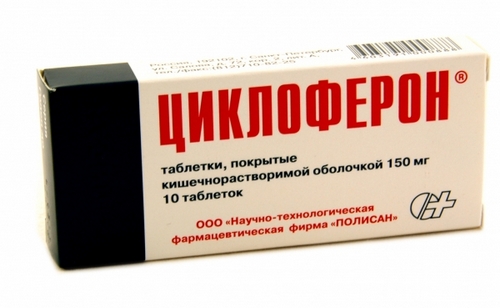
Immunostimulating drugs for influenza
These medications are inexpensive but effective. These include the following funds.
- Cycloferon. Effective for colds and flu, herpes and papillomavirus. Cycloferon is aimed at inducing interferon. Thanks to this action, the immune system begins to show antiviral and anti-inflammatory protection. It has a number of contraindications in the form of liver diseases, allergic manifestations, diseases of the digestive system and individual intolerance. The average price for the drug ranges from three hundred rubles.
- Viferon. A drug with antiviral and immunostimulating properties. Available in the form of candles. The main indications include ARVI, influenza, herpes. The treatment course is five to seven days. Viferon suppositories can be used by pregnant and lactating women. The main contraindication is the individual intolerance of the active ingredients. The cost of Viferon ranges from two hundred and fifty rubles.
- Grippferon. Medicine for flu and colds. Produced in the form of nasal drops. It is used as a treatment and prevention of flu and colds. Has efficiency in relation to various viruses, which includes adenoviruses, influenza viruses, parainfluenza and rhinoviruses. When using Grippferon, no additional symptomatic treatment is required. He is able to weaken the unpleasant symptoms of the disease in the form of nasal congestion, runny nose, pain in the throat and head in the first day. It is not recommended to use the medicine for children and adults who have allergic reactions. It is worth noting that Grippferon can be used against and breastfeeding.

Antiviral medicines for children
AT childhood the flu and colds are much harder and last longer. To boost immune function and fight the virus, doctors also recommend giving antiviral drugs. In their composition, they contain substances that have immunostimulating, antiviral and anti-inflammatory properties. To include the following.
- Viferon. Available in the form of candles. You can use the product immediately after birth. The active substance is human interferon. The treatment course is five days. The average cost of Viferon is two hundred and fifty rubles.
- Anaferon. Approved for use in children from the first month of life. It is available in the form of tablets that dissolve easily in water. The average price fluctuates around three hundred rubles.
- Ergoferon. An antiviral drug that can be given to children from six months of age. Helps to overcome unpleasant symptoms in the form of nasal congestion, discharge, elevated temperature and sore throat. An analogue of Ergoferon, but it is more effective against the influenza virus, as it is a more modern remedy.
- Oxolinic ointment. An excellent remedy for flu and colds. It is used not only for medicinal purposes, but also for preventive purposes. It is enough to lubricate your nose every time before going outside during an exacerbation. A fairly cheap and affordable tool that can be used in children of any age.
- Grippferon or Interferon in ampoules. Nasal drops that protect the nasal mucosa from the multiplication of the virus. Can be used in children from the first month of life. As a preventive measure, you need to instill one drop of the product in each nostril up to twice a day. In case of infection, the dosage is recommended to be increased to two drops.
- Kagocel. The drug for influenza and colds. Approved for use in children from six years of age. It can be used even with late treatment. Suitable for preventive purposes.

Symptomatic treatment for influenza
Also, in pharmacy kiosks, drugs are presented that can remove the symptoms of the disease. They will not help get rid of the flu and SARS and only temporarily relieve you of unpleasant manifestations. These drugs are usually classified as follows.
- Coldact Plus. It is produced in the form of capsules, the active component of which is paracetamol and ascorbic acid. You need to take them one capsule every twelve hours. When treating with this remedy, it is recommended to completely abandon alcohol intake.
- Coldrex. Available in pill form. Able to help with colds that manifest wet cough... You need to take one tablet up to four times a day. The remedy is contraindicated in people with diabetes mellitus, hepatic and renal insufficiency.
- Rinzu. A drug that works great for the symptoms of colds and flu. Available in pill form. You need to take them up to four times a day. Cannot be used during gestation and breastfeeding, and is also prohibited for children under fifteen years of age. The treatment course is at least five days.
- Fervex. The drug is available in powder form. It is enough to add the product to hot water and take. The active ingredients are paracetamol and vitamin C. It is not recommended to consume more than three days. There are two types: children and adults. Children are allowed to use for four years.
- Antigrippin. Available in powder and effervescent tablets. Chlorphenamine and ascorbic acid act as active substances, which ensures the removal of swelling of the nasopharyngeal mucosa, and constricts the vessels. Approved for use in adults and children from the age of two.
Plant-based antiviral flu medications
There are antiviral drugs for influenza that are plant-based. They can be taken by children different ages and adults, pregnant and lactating women. To the list better means can be attributed to the following list.
- Oscillococcinum. Homeopathic medicine with antiviral and immunostimulating properties. It is produced in granules, which, when taken, dissolve quickly enough in the mouth.
- Echinacea. Can be used as an immunostimulating agent. But it is also effective against cough.
- Imupret. It includes walnut, horsetail and oak bark.
- Gossypol. A preparation based on natural cotton polyphenol.

Other types of flu medications
Often, flu and colds are accompanied not only by fever, nasal congestion and general weakness, but also by sore throat and runny nose. Along with antiviral drugs for influenza, you can take other medicines for complex treatment. The following remedies will help from a sore throat and sore throat.
- Grammidin. Available in the form of lozenges. There are many varieties, one of which is anesthetic pills. It is good to take them at night, as they not only soothe the throat, but also have analgesic properties. The treatment course is about seven days. They need to be consumed up to four to five times a day.
- Faringosept. An excellent drug that has a powerful effect. It is prescribed for children over six years old. The tablets should be absorbed after meals up to five times a day.
- Lizobact. Plant-based lozenges. They are recommended for use during gestation and breastfeeding, for children from the age of two and for adults. The treatment course is up to seven days.
- Strepsils. The tool is available in the form of tablets. It is able to eliminate the painful feeling, and also has antiseptic properties. Approved for use in children over five years old. The treatment course is three to four days.
To relieve nasal congestion and overcome a runny nose, you can use drugs in the following form for the flu.
- Sanorin, Nazivin. They have a vasoconstrictor effect. Will help relieve congestion up to six hours. It is recommended to use only in extreme cases and no more than five days, as drugs can lead to dependence.
- Pinosol. An excellent drug that has three forms of release: drops, spray and ointment. It contains essential oils, due to which not only nasal congestion is eliminated, but the runny nose disappears and microbes are killed. Approved for use in children.
- Aqua Maris. A product aimed at moisturizing the nasal mucosa. Does not dry out blood vessels and accelerates the healing process. The preparation contains sea water.
- Vibrocil. A drug against the virus and allergic manifestations. It has not only a vasoconstrictor effect, but also an antihistamine. Copes quickly with germs and relieves puffiness.
Antipyretic drugs include the following.
- Paracetamol. One of the best drugswhich relieves fever and pain... Refers to inexpensive and affordable means. Available in the form of tablets, syrup and suppositories. Can be used by children from three months.
- Ibuprofen. A good effective drug that has anti-inflammatory and antipyretic properties. Can be given to children from one month of age.
- Aspirin or acetylsalicylic acid... Approved for use in children over twelve years of age and adults. It is strictly forbidden to take small children, pregnant women and people suffering from poor blood clotting.
Preventive measures to prevent influenza
Don't look for the best cures for flu and colds. They can suit some people, harm others. Each organism is individual and has its own sores. During gestation and children under seven years of age, it is better to use folk methods treatment. They will not harm health, have no contraindications and side effects. But the road to recovery will be much longer. Therefore, experts recommend strengthening the immune system.
- Leading a healthy lifestyle.
- Performing daily charging.
- Eating healthy and vitamin-rich foods.
- Taking vitamin complexes during exacerbations.
- Airing the room up to three times a day and humidifying the air.
- Walking for at least one hour a day.
- Refusal to visit crowded places during the period of infection. If this cannot be avoided, then the nose should be lubricated with oxolinic ointment.
When the first signs of influenza appear, the treatment process must be started immediately.
Due to the flu epidemic and sharp rise the incidence of ARVI from pharmacy counters literally swept away all drugs that are advertised on TV and in the press, on the Internet as "antiviral". But is it worth doing, and will they help adults or children to recover faster and prevent complications?
Despite the extensive advertising campaign for these drugs, which is ordered by pharmaceutical companies, today there is no definite proof of the action of drugs from most pharmaceutical groups. But, in fairness, it is worth noting that there are effective drugswhich, according to doctors, work quite well.
Treatment of viral infections (influenza, ARVI) is based on the use of several pharmacological groups of drugs that have different effects and points of application. In addition, doctors have their own experience in treatment.
Is there a perfect cure for viruses?
Now, most of the "antiviral" drugs against influenza and ARVI on the domestic pharmacy market are united by the following fact - most of them, with rare exceptions, have no proven antiviral efficacy. This is because global and meaningful drug research is costly and is therefore carried out only by the manufacturers themselves or by those interested in good conclusions.
In addition, most of the positive clinical trials on new drugs are regularly faked in order to bring a new drug with a "miracle effect" and a high price to the market. It is extremely profitable to produce and sell "antiviral" drugs, because colds are the most common type of disease; during epidemics, sales increase tenfold. Therefore, independent experts and specialists from the field of pharmacy and medicine do not believe in the objectivity of such studies.
Even in scientific medical journals, articles on the topic of pharmacology today are 90% of the order and advertising nature. And on the pharmacy counters there is an abundance of various kinds of medicines and dietary supplements, homeopathy, which, in fact, have little to do with the treatment of a viral infection - these are either fakes, ineffective means, or just dummies. But wide and aggressive advertising campaigns allow manufacturers to get millions on drugs.
Types of drugs for flu and colds
Due to the fact that drugs in this group have different mechanisms of action, and are aimed at different links of viral infection, there is no single drug that would be definitely the best in the treatment of influenza and ARVI. In addition, each type of drug can have a different effect on a particular patient. In many ways, the effect of therapy depends on the duration of the disease, the degree of the patient's immune response, types of viruses, and the presence of concomitant, including autoimmune pathologies. Also, the choice of drugs largely depends on the allergic background and the likelihood of adverse reactions.
According to modern rules, the treatment and prevention of influenza and ARVI should include several points:
- vaccination before the start of the epidemiological season,
- taking drugs from the interferon group,
- the use of antiviral drugs that suppress viruses,
- taking drugs of immunostimulating action, to stimulate their own immunity.
Often, various kinds of complex preparations, homeopathy and symptomatic therapy are also mixed here. They have no effect on viruses, but they sell well.
Vaccination - the question is complex and controversial. For the manufacture of vaccines, the strains of viruses predicted for the next year are used, but sometimes the forecasts are not justified. This year they planned to vaccinate against H3N2 influenza, while now the H1N1 swine flu is raging. Moreover, vaccination is not therapeutic, but preventive measure, during a flu epidemic, it is simply useless to vaccinate against it. On its introduction healthy body after a while, it must react with the production of antibodies, this is two to four weeks, during this time the epidemic season may end or the patient may become infected.
Interferon-based preparations
Interferons are classified as specific proteins synthesized by cells in response to the invasion of various types of viruses into the body. After the viruses enter the cell, interferon is released, a reaction is triggered in which the cells become immune to viruses. This stops the virus from multiplying and prevents it from spreading inside the body. The body has its own interferon, but its synthesis at the onset of the disease is delayed. This explains the effect of early administration of interferon. Some of the commonly used drugs in this group are:
VIFERON, a drug of complex action against viruses used in the treatment of influenza and ARVI, as well as herpes infections, hepatitis, etc. A combination of Viferon with other drugs is often used. The drug is produced in the form of rectal suppositories, ointments and gel. The preparation contains human interferon-alpha in combination with ascorbic acid and vitamin E, in candles, cocoa butter is taken as a basis.
Viferon causes suppression of viruses, stimulation of the production of its own interferon, an increase in the production of antibodies to viruses, and has an immunomodulatory effect. According to the manufacturer, the effect of normalizing the level of immunoglobulins in combination with vitamins is noted, while there are practically no side effects. Of the contraindications, only allergic reactions to the components of the suppositories.
The effectiveness of Viferon has been researched and proven only in clinical trials in our country. There have been no international studies meeting all the standards. According to practicing pediatricians and therapists, the greatest effect is observed with early therapy with Viferon. In some cases, the use of Viferon reduced the duration of antimicrobial therapy.
GRIPPFERON - contains interferon-alpha in the composition, has the form of a spray, drops and ointment in the nose. It is used to treat ARVI and influenza in adults and children, in nursing and pregnant women. The drug is credited with antiviral, anti-inflammatory and immunomodulatory activity, but there have been no serious scientific studies on this drug in the world. It has no side effects and contraindications, it is usually used in combination with other drugs.
Direct antiviral drugs
Funds from this group have a direct effect on the influenza virus, which leads to a violation of its division, and the virus is blocked when it enters the cell. In addition, there is also an additional effect in terms of stimulating the production of its own interferon.
To date, proven (international and full-fledged studies) antiviral effects have only rimantadine (orvirem for children), tamiflu and relenza... All other drugs marketed as anti-influenza drugs are either insufficiently researched or have many side effects, or there is no complete data on their safety.
RIMANTADIN has long been known as a drug for the prevention and treatment of influenza type A. It slows down the multiplication of influenza viruses and blocks their entry into cells. The drug has been known since the 70s of the last century, during this time many different kinds of studies have been carried out that have proven its effectiveness and revealed all its disadvantages and side effects. The majority of patients who used rimantadine for influenza A showed significant relief of symptoms and a reduction in the duration of illness. The drug is indicated only for the prevention and treatment of influenza A. Contraindicated in children under seven years old, pregnant women, people with kidney and liver problems.
The drug can cause side effects in the form of nausea with vomiting, stomach pains, dizziness. Blood bilirubin levels may increase. Rimantadine should be used with particular caution in people with high blood pressure in old age, as the risk of strokes is increased.
ORVIREM - a special form of rimantadine for children, it is a copolymer of rimantadine with sodium alginate, leveling its toxic effects in children. The presence of this alginate significantly reduced the negative effects of rimantadine and made it possible to use it in children. Due to sodium alginate, adsorbing and detoxifying properties appear, which helps in the antitoxic activity of the drug. With this form of the drug, rimantadine is absorbed into the blood slowly, gradually increasing in concentration and reaching a stable value. This allows the drug to actively fight the flu, although its effectiveness has been proven for other acute respiratory viral infections. The drug is prescribed for children from 1 year of age with influenza A, adenovirus, MS and mycoplasma infection. It is less effective for influenza B.
Taking orvirem for influenza leads to suppression of the multiplication of viruses and activation of the synthesis of its own interferon, which enhances the effect of the drug and helps reduce the risks of laryngitis and pneumonia with influenza.
TAMIFLU (OZELTAMIVIR) indicated only for influenza types A and B, and does not give an effect in ARVI. It is not used for prophylaxis due to toxicity, they cannot be treated for a long time - it can lead to mental disorders and toxic damage to the kidneys. Applied for adults and children from 1 year old. Available in the form of capsules and powders for suspension preparation.
Suppresses the reproduction and growth of viruses, is active against influenza A and B, but works better against the former. Indicated only during the season of epidemics and pandemics to reduce the risk of mortality and complications. Contraindicated in pregnancy, renal failure and allergies to the components of the drug. Side effects include insomnia and headaches, nausea with vomiting, abdominal pain and coughing.
Studies of the drug are still underway to this day, the drug is recognized as toxic, and in some countries of the world it is not used. In our country, practicing doctors note its positive effect, but use it carefully.
RELENZA (ZANAMIVIR) is an analogue of Tamiflu, has a substance similar in effect in its basis. Refers to antiviral drugs. The treatment regimen, side effects and contraindications are similar to those of Tamiflu. Its further research is also underway, although the drug has shown itself well in the fight against type A influenza.
PERAMIVIR refers to new drugs against influenza, the effect is similar to Tamiflu, today it has been approved (since 2014) in Japan, Korea, America. It has a pronounced effect from the first application, but so far there is no convincing data on its safety, although research on it is underway and the prospects are good.
AMIXIN (tilorone, lavomax) antiviral, immunomodulatory drug that stimulates the production of its own interferon. Has side effects in the form of chills, allergic reactions, prohibited for pregnant and lactating women, prohibited in children under 7 years of age.
According to research, it is effective in the prevention and treatment of influenza and SARS, but there is also evidence of potential harm to health. When conducting research on animals, it showed a toxic effect on the liver and retina. Not applicable in the USA and Europe, in our country it is applicable under the Amiksin brand. In a study on volunteers, the drug produced changes in the retina and cornea of \u200b\u200ba reversible nature without impairing vision. Therefore, its application is limited and further research is still underway.
INGAVIRIN - a preparation from new antiviral agents, based on vitaglutamate, is active against influenza A and B viruses, adenovirus infection. It has an immunomodulatory effect, anti-inflammatory properties. It is produced in the form of capsules, indicated for the treatment of influenza and ARVI, the treatment regimen is determined by the doctor. Contraindicated in children under 7 years of age, pregnant women, people with allergies to the drug. Side effects are usually in the form of allergies.
To date, the effectiveness of therapy for influenza and colds has not been proven by international studies, a pronounced effect of treatment is not observed, the period of illness may be slightly reduced.
ARBIDOL is positioned as a means of suppressing influenza A and B viruses, as well as many types of ARVI, intestinal viruses. The effect of arbidol is explained by a shortening of the period of the disease and a decrease in symptoms of intoxication. The substance is non-toxic, does not cause serious side effects during therapy. The active ingredient is umifenovir. Applied in the form of capsules, is contraindicated for up to three years and during pregnancy.
The effectiveness of the drug in the world has not been proven, it is applicable only in our country, there is no clear evidence of its effectiveness, the opinions of doctors and patients are ambiguous - there are both positive and negative reviews about it.
Immunostimulating drugs
Immunostimulants that are produced by today's pharmaceutical companies are active against in vitro immune responses, at the laboratory or animal level. And their real benefits and the possibility of long-term consequences when using them is a poorly studied and rather complex area of \u200b\u200bpharmaceuticals. The mechanisms of immunity themselves became known not so long ago, and every year more and more new information appears in this area. Therefore, specialists do not have a firm conviction that it is safe and correct to stimulate an unexplored body system. It is especially necessary to be wary of such methods of stimulating immunity and treatment with drugs of this action in children.
One of the groups of immunostimulants widely used now is interferon inducers. As mentioned above, the synthesis of its own interferon is often delayed, giving the viruses a head start from one to two days. Interferon stimulants are aimed at accelerating and enhancing its synthesis.
CYCLOFERON - interferon inducer, has antiviral and immunostimulating effects. A relative anti-inflammatory effect was also noted. Indications for taking cycloferon are influenza, SARS, herpes, hepatitis. Applied in the form of tablets, injections, liniment. The drug is prescribed for children from 4 years of age and adults.
The drug triggers the synthesis of alpha and beta interferons, which reduces the susceptibility of cells to the virus. This slows down its reproduction. The immunostimulating effect is achieved by correcting the patient's immune status, activating special killer cells of the immune system, which remove cells affected by the virus. The drug is contraindicated for cirrhosis of the liver, in pregnant women, during breastfeeding, in case of allergy to the drug.
The effectiveness of the application has not yet been confirmed by large-scale international studies, but in individual clinical trials there are indications of a good effect from the application. The use of the drug enhances the effectiveness of many antibiotics, does not cause the development of autoimmune diseases.
KIPFERON - refers to antiviral, immunomodulatory drugs that have anti-inflammatory and antimicrobial effects. Has the form of vaginal and rectal suppositories. It is indicated for influenza and acute respiratory viral infections, adenovirus and intestinal infections, in gynecology.
The basis of the action of interferon is the induction of the synthesis of its own interferons, which leads to an increase in the nonspecific protection of cells. This inhibits the multiplication of viruses and leads to their destruction. Contraindicated in case of individual intolerance, allowed during pregnancy and lactation. No side effects have been identified. But the drug's effectiveness has also not been tested in large-scale studies. According to the practice of doctors using the drug, it works for viral infections, including ARVI and partly for influenza.
TYLORONis a synthetic substance, an interferon inducer. Stimulates the formation of all types of interferon in the body. Sold in pill form, indicated for influenza, SARS, viral encephalitis. Contraindicated in pregnancy and lactation, as well as in children under seven years of age. Side effects include allergic reactions to the components of the drug, headaches with chills. The drug has been produced for 40 years, its effectiveness has been proven clinically and as a result of numerous studies. But there is also an opinion of experts from many clinics about the toxicity of the drug, although practitioners point to its obvious effectiveness. It should be applied carefully, as recommended by a doctor.
KAGOCEL refers to interferon inducers, is applicable in the treatment of all types of influenza and ARVI. It is recommended to start treatment with Kagocel on the first day of the disease so that it has an effect. Kagocel contains the substance gossypol, which is active against influenza viruses. When taking one single dose, there is an increase in the amount of interferon in the blood to the maximum doses, which determines its effectiveness. Contraindicated in pregnant and lactating women, children under three years of age. Side effects are mainly allergic reactions to the drug.
However, when studying the drug, Western clinics come to the conclusion that treatment with Kagocel leads to undesirable consequences, since gossypol is toxic. In the opinion of domestic scientists, this harm has not been proven, so we are stubbornly selling it. According to the experience of clinic doctors, the effect is individual, it helps someone very well, someone does not.
CITOVIR 3- a drug with complex effects, which contains bendazole, thymogen and ascorbic acid. On the market it is positioned as an interferon inducer, equal in effect to Kagocel and Tilorone. At the same time, the developers claim that bendazole enhances the production of interferons in the shortest possible time. It is released in capsules, syrups and powder for solutions. It is indicated for the treatment of influenza and acute respiratory viral infections in the early stages. Contraindicated in children under one year old, pregnant and lactating. Of the side effects - it has the ability to lower blood pressure and gives allergies. It is difficult to judge the effectiveness, he did not undergo randomized trials. Reviews about it vary from effective to zero, a positive effect is not excluded due to the fact that the body simply copes with the infection itself.
ERGOFERON AND ANAFERON are classified as drugs of immunostimulating action, which enhance the immune defense and antiviral activity of the body. Indicated for the prevention and treatment of influenza and ARVI in children and adults, including pregnant and lactating women. They do not cause serious side effects, nor do they give high efficiency, are contraindicated in case of lactose intolerance and allergies.
RIDOSTIN - a high molecular weight drug from the group of naturally occurring interferon inducers. It looks like a strand of RNA obtained from special yeast. It is used by systemic administration in injections, the accumulation of interferon is noted after 6-8 hours from the moment of injection. It has a pronounced immunomodulatory effect, increases the level of corticosteroid hormones in the blood, is used in the treatment and prevention of influenza and ARVI. Contraindicated in pregnant and lactating women, persons with liver and kidney damage.
DIBAZOLused for the prevention and treatment of influenza and ARVI. It has immunomodulatory activity, helps in the production of endogenous interferon, and has been proven to be clinically effective for many years.
Homeopathic and herbal preparations
OTSYLLOCOCCINUM - homeopathic remedy for the prevention of influenza and ARVI, for the treatment of milder forms. Applicable at any age, contraindicated in lactose intolerance. There are no global studies on the effectiveness of the drug, opinions and reviews are different, mostly indicated as ineffective.
AFLUBIN- a homeopathic remedy used for the prevention and treatment of ARVI and influenza. According to the developers, it has anti-inflammatory, immunostimulating effects and eliminates intoxication. It helps to quickly eliminate the symptoms of a cold. It is indicated at any age, in pregnant and lactating women, there are no side effects. The effectiveness has not been proven, there has been no global scientific research on effectiveness.
IMMUNAL- a herbal preparation based on the echinacea plant. The drug has an immunostimulating, antiviral effect. Used for the prevention of flu and colds, the course is from a week to two months. Has no effect in treatment. Allowed for children from 1 year old, adults, during pregnancy should refuse to take it. May cause allergies.
Photo - photobank Lori
Date of publication 27.01.2016
Article author: Alena Paretskaya
